The line between medicinal and poisonous plants is very thin. Sometimes the very thing that heals you can kill you if you consume too much of it. And that is as true of pharmaceuticals as it is for plants.
But over time, we have become convinced that a chemical synthesized in a lab is safer than a plant that grows in nature.
However, a trained herbalist knows how to use poisonous plants in the same way a doctor knows how many pills to tell you to take.
Always use extreme caution when dealing with poisonous plants because many, if used improperly, can cause death!
Related: 8 Edible Backyard Plants And Their Poisonous Lookalikes
Foxglove
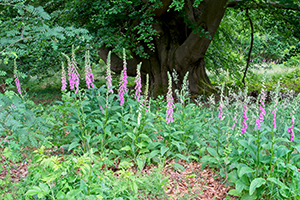 Foxglove, Digitalis purpurea, always comes to mind first when I think of poisonous medicinal plants (probably because I read a lot of murder mysteries when I was young). A common garden plant, foxgloves are grown for their beautiful flowers despite their deadly reputation.
Foxglove, Digitalis purpurea, always comes to mind first when I think of poisonous medicinal plants (probably because I read a lot of murder mysteries when I was young). A common garden plant, foxgloves are grown for their beautiful flowers despite their deadly reputation.
All parts of the plant are toxic, and you can feel the effects even if you ingest just a small amount of the plant. Symptoms include nausea, vomiting, and diarrhea.
However, the same toxic compounds can also be used medicinally. These compounds are called glycosides. The glycosides present in foxglove are called digitalis, after the Latin name of the plant.
Survival Uses
Traditionally foxglove was used to treat dropsy, now known as edema, a swelling condition related to cardiac problems. Nowadays, digitalis is still extracted from foxglove leaves and used to make heart medicine.
When SHTF and there aren’t any pharmacies or doctors, foxglove can be used with extreme caution to treat heart problems. While accidental death is uncommon, it is possible.
Related: Foxglove Utilized to Treat Heart Disease During the Civil War
Tansy
Tansy, Tanacetum vulgare, is another common garden plant with a nefarious reputation.
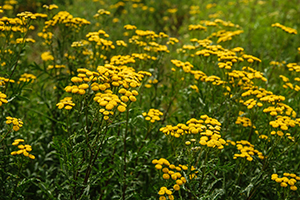
Featuring fragrant ferny leaves and bright yellow flowers, it is easy to see why tansy is popular. Like foxglove, it was once commonly used in herbal medicine to treat many ailments, including worms, nausea, and kidney problems. But over time, its toxic nature led people to look for safer choices.
While you can eat the leaves in small amounts, large amounts of tansy can be deadly, so use caution. The essential oil it contains is considered toxic.
However, medicinal tansy can be used externally for sprains and bruises or as an herbal wash. Simply brew an infusion of the leaves and flowers. You should always spot test with tansy first as it can cause skin irritation in people.
Medicinal Uses
Tansy should only be used externally. You can make a poultice with fresh tansy leaves to alleviate swelling from sprains and aid wound healing.
However, tansy can cause contact dermatitis so use caution and test a small area of the skin first.
Yellow Dock
Yellow Dock, Rumex crispus, also known as curly dock, is a common wild edible. People forage for leaves to eat and use the root medicinally. The root can be boiled and used to detox, treat liver ailments, and as a laxative.
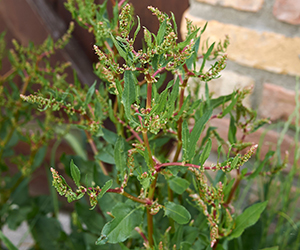
But this useful plant has a dark side as well.
The leaves contain oxalic acid, which can be poisonous when consumed in large quantities. You can eat a few leaves raw, but you should cook them if you plan to eat more than a few.
Cooking will reduce the amount of oxalic acid in the leaves.
Consuming too much oxalic acid can lead to severe mineral deficiencies—especially a deficiency in calcium. Calcium deficiency can cause fatigue, seizures, and confusion.
Dock Infused Oil for Itching
- Fill a jar ¾ of the way with fresh, dry dock leaves. Make sure you use only healthy, undamaged leaves.
- Cover your leaves with a carrier oil, like olive, sesame, or coconut oil. Make sure your leaves are completely covered and close the jar.
- Leave the jar undisturbed in a sunny window for 4-6 weeks. Then strain the leaves and place the oil in a clean jar.
- You can apply the oil as is to relieve itching or add it to salves or balms.
Castor Beans
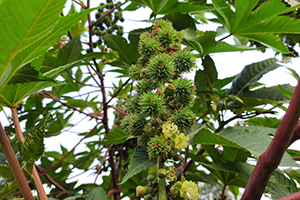 Castor Oil is a popular traditional remedy for constipation. Its antibiotic, antifungal qualities make the oil excellent at relieving skin irritations, acne, and fungal infections.
Castor Oil is a popular traditional remedy for constipation. Its antibiotic, antifungal qualities make the oil excellent at relieving skin irritations, acne, and fungal infections.
It also makes a wonderful oil choice for a base for medicinal salves and balms. But this magical oil comes from a deadly plant.
Castor oil comes from pressing the hulled beans of the castor plant, Ricinus communis. It is essential to remove the outer shell or hull of the bean before use.
The hull contains ricin, which is a deadly poison. Ricin is so toxic that it can kill an adult who has chewed as few as 1-6 beans!
Once you remove the shell, the beans are safe. However, castor oil should not be consumed for long periods of time as it can lead to a potassium deficiency. It should also be avoided by pregnant women unless they are full-term and looking to induce labor.
Castor Oil
- For constipation: Take ½ an ounce of castor oil to relieve constipation. You can mix the oil
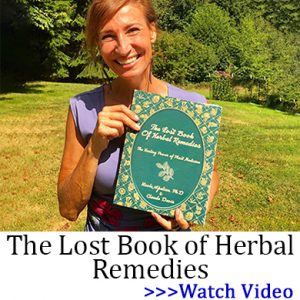 with juice to improve the flavor. You should notice the effects in about 2-3 hours though it may take as long as 6 hours. However, you should avoid taking castor oil before bed.
with juice to improve the flavor. You should notice the effects in about 2-3 hours though it may take as long as 6 hours. However, you should avoid taking castor oil before bed. - For skin: You can apply castor oil topically to help alleviate a number of skin conditions. It can help with wound healing, acne, and moisturize your skin.
Related: How To Make Oil From Plants At Home
Stinging Nettles
Poison comes in many different forms, and not all of them are deadly.
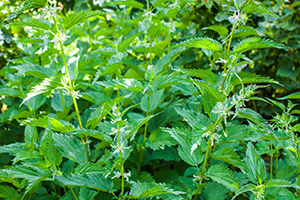
Stinging Nettles, Urtica dioica, is a prime example of a non-deadly poisonous plant with many medicinal uses.
As the name suggests, when you touch these nettles, you experience contact dermatitis. Which is really just fancy for saying it gives you a rash.
But that means you don’t want to consume stinging nettle raw. Just imagine all those stinging hairs in your throat. When you cook the leaves, you neutralize all the toxins. Then you can add these nutritious leaves to your food or use them medicinally.
Nettles can help treat pain and inflammation, hay fever, lower blood pressure and blood sugar, and aid in healing wounds. You can simply add a cup of delicious nettle tea to your daily routine to get the health benefits of this poisonous plant.
Nettle Tea
- 1 cup of fresh nettles
- 2 cups of water
- Honey or another natural sweetener to taste
Boil two cups of water. Add the nettles. Allow the nettles to steep for between 5-15 minutes, depending on the strength you want. Strain the nettles. Add your sweetener. Then enjoy!
Final Thoughts
When dealing with any medicine, herbal or pharmaceutical, it is important to use caution. Often the line between potent and toxic is very thin. However, when used with care, these poisonous plants can be lifesaving.
Thorough knowledge of plant medicine will be essential in order to survive when SHTF. Without doctors and pharmacies, we will once again need to rely on what nature can provide for us.
Being able to identify common plants like yellow dock and stinging nettles can help you cope with common ailments. Learning to masterfully brew infusions of foxglove comes with time and study.
In the end, nature provides us with what we need to survive. We just need to be open enough to see it.
Source: askaprepper.com
Survival Books
THE LOST BOOK OF REMEDIES-All Medicinal Plants and Lost Cures of North America
THE LOST WAYS-Learn the long forgotten secrets that helped our forefathers survive famines,wars,economic crisis and anything else life threw at them
EASY CELLAR-AMERICA’S NATURAL NUCLEAR BUNKERS: FIND THE CLOSEST ONE TO YOUR HOME
THE LOST WAYS 2-This lost super-food will bulletproof you against any food shortage or famine
BLACKOUT USA-EMP survival and preparedness guide
DIY HOME ENERGY-Follow the step-by-step guide from A to Z and you will have a working system to reduce your electricity bills and save energy
MY SURVIVAL FARM-This hidden survival garden will keep you well fed when SHTF
CARNIVORE’S BIBLE -THE REAL HOMEMADE AND HEALTHY MEATY TREATS OUR GRANDPARENTS USED TO MAKE…


2 Replies to “5 Poisonous Plants That Can Be Used As Medicine When SHTF”